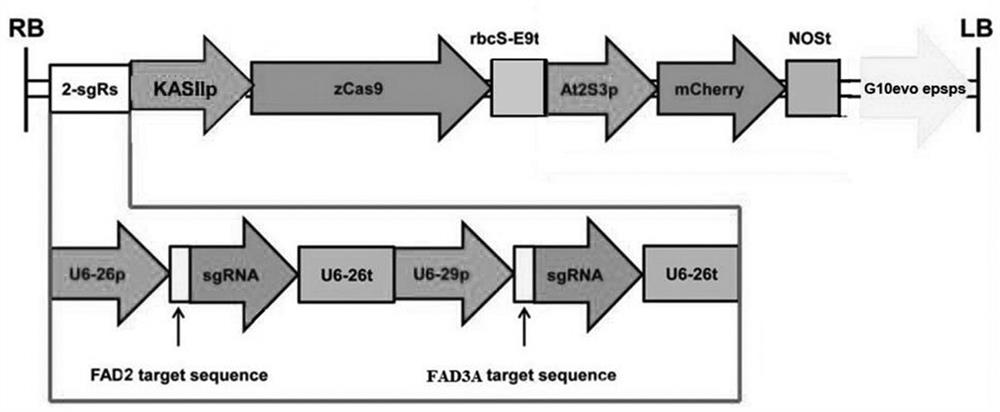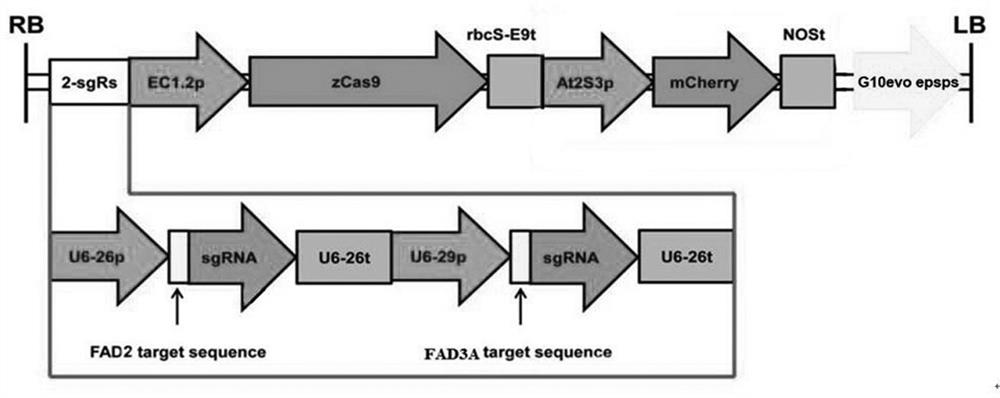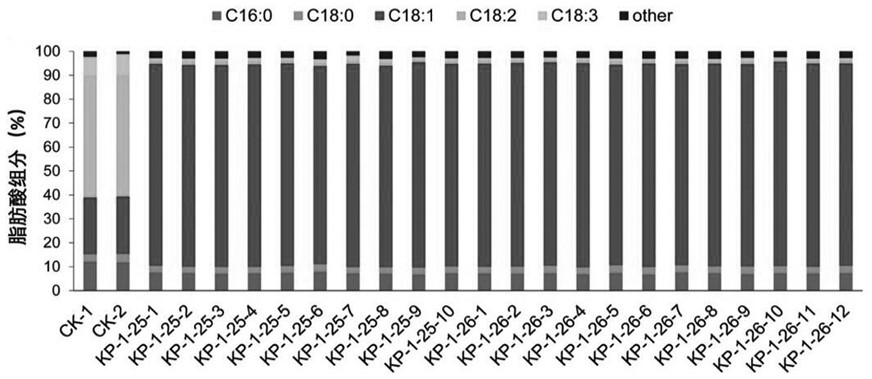Gene mutant for improving soybean oleic acid content and application thereof
A soybean oleic acid, single-gene mutation technology, applied in the application, genetic engineering, plant genetic improvement and other directions, can solve the problems of reducing nutritional value, affecting oil quality, poor stability, etc.
- Summary
- Abstract
- Description
- Claims
- Application Information
AI Technical Summary
Problems solved by technology
Method used
Image
Examples
Embodiment 1
[0039] Embodiment 1: Obtaining of transgenic soybean plants
[0040] Electric shock transformation of Agrobacterium tumefaciens: Take 1 mL each of the constructed CRISPR / Cas9 gene editing vectors EP and KP and add them to Agrobacterium tumefaciens EHA105 competent cells, mix well, and transfer to the electric shock cup. Put the electric shock cup into the sample slot of the electric shock instrument, and select the appropriate voltage for electric shock (2.0mm, 2500V) according to the distance between the electrodes of the electric shock cup. Add 1 mL of YEP liquid medium without antibiotics to the electroshocked Agrobacterium tumefaciens, mix well, transfer to a sterilized 1.5 mL centrifuge tube, and incubate at 28°C for about 3 hours. The bacterial solution was centrifuged at 4000rpm for 3min, and the supernatant was discarded. Mix the remaining YEP liquid medium and precipitated bacteria, evenly spread it on the YEP solid medium plate containing 12mg / L rifampicin and 50mg / ...
Embodiment 2
[0044] Example 2: Utilizing fatty acid component analysis method to screen mutated soybean grains
[0045] With reference to the method of Zheng et al. (2003; Plant Cell 15:1872-1887), the obtained T2 generation soybean seeds were analyzed for fatty acid components, and the specific implementation steps were as follows:
[0046] (1) Fix the soybean grains, cut off the cotyledons (about 40mg) accounting for 1 / 4 of the total volume of soybeans at the end far away from the hilum with a clean blade along the direction parallel to the hilum, chop them and place them in a 2ml imported centrifuge tube , add glass beads, and then add internal standard C17:0 (dissolved in n-hexane, ready to use). The rest of the seeds were planted in the pre-prepared substrate (about 1 cm in depth), with the hilum facing down, for subsequent molecular identification;
[0047] (2) Close the lid tightly, carry out crushing treatment in the tissue crushing instrument, and centrifuge;
[0048] (3) Transf...
Embodiment 3
[0051] Example 3: Detection of gene editing sites in transgenic positive plants FAD2-1A, FAD2-1B and FAD3A, while detecting the presence or absence of the Cas9 protein gene
[0052] After fatty acid component analysis, seeds with an oleic acid content greater than 80% were selected for planting, and the oleic acid content among different seeds in the same selected strain was the same or similar. The KP transgenic T2 generation plants were obtained, and the genomic DNA of the leaves of the KP transgenic T2 generation plants was extracted.
[0053] Then, use genomic DNA as a template, design primers so that the amplified product is a sequence of 150-250 bp near the target sequence, and carry out a conventional PCR reaction. The designed primers are shown in Table 2 below.
[0054] Table 2: List of primer sequences.
[0055]
[0056] Finally, the PCR product was detected by polyacrylamide gel electrophoresis for mutation of the target sequence. The specific electrophoresis me...
PUM
 Login to View More
Login to View More Abstract
Description
Claims
Application Information
 Login to View More
Login to View More - R&D
- Intellectual Property
- Life Sciences
- Materials
- Tech Scout
- Unparalleled Data Quality
- Higher Quality Content
- 60% Fewer Hallucinations
Browse by: Latest US Patents, China's latest patents, Technical Efficacy Thesaurus, Application Domain, Technology Topic, Popular Technical Reports.
© 2025 PatSnap. All rights reserved.Legal|Privacy policy|Modern Slavery Act Transparency Statement|Sitemap|About US| Contact US: help@patsnap.com



